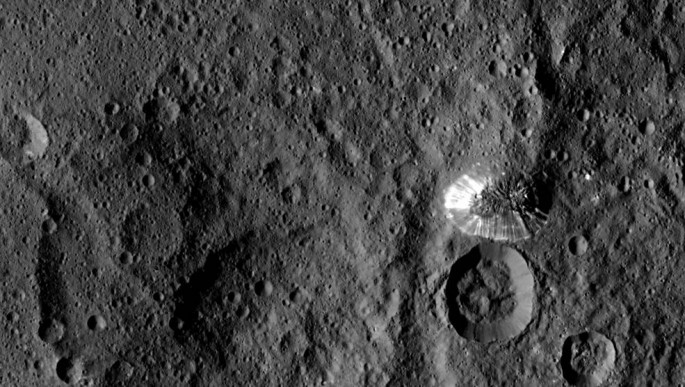NASA's Dawn spacecraft has been observing dwarf planet Ceres as it captured stunning images of the alien world's complex surface that includes a strange, cone shaped mountain that spurred interest from scientists.
The first images of the "pyramid" that was taken by the Dawn probe happened months ago where the mountain is estimated to reach 21,120 feet adding much curiosity from conspiracy theorists as they claim that it was "too regular to become natural". However, scientists dispute this by saying that the pyramid mountain was completely natural.
These new images were taken last August 19 some 915 miles above Ceres where scientists have dubbed this as the "lonely mountain" since it is not part of any observable mountain range on the surface and upon closer inspection, details reveal that this pyramid was rather more conical in shape.
Apart from its distinct shape, the mountain is also covered with bright streaks of material from an unknown source that are also similar to the dwarf planet's mysterious, bright, white spots that can be potentially ice or salt continuing to be an enigma for scientists.
NASA officials reveal that the borderline regions of the base of the mountain possess sharply defined features where there is almost no visible accumulation of debris from the base to the slope.
Using high-resolution cameras, the probe also utilizes a visible and infrared mapping spectrometer to gather data on Ceres where the dwarf planet is located in the asteroid belt between Mars and Jupiter.
As Dawn maneuvered into closer orbit around Ceres, the images now show sharper impact features such as craters and ridges. According to Dawn mission director, Marc Rayman of NASA's Jet Propulsion Laboratory, Dawn is now at its peak performance with this new orbit during this ambitious exploration.
Currently, the spacecraft's view is now three times sharper than its previous mapping orbit that reveals newer details of this mysterious dwarf planet. The mission team will conduct 14 complete orbits for Dawn to to map the entire surface of Ceres where in the next two months, it will also document six complete views.
In late October, the spacecraft will zoom into closer orbit at 230 miles from the surface, capturing even more unprecedented views.



























